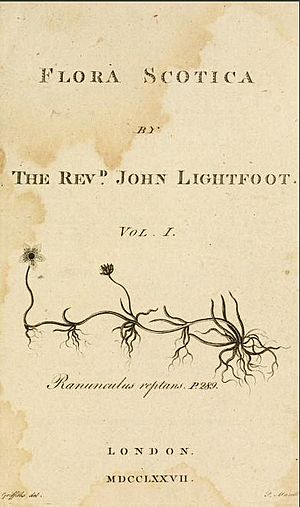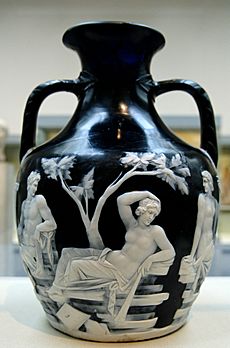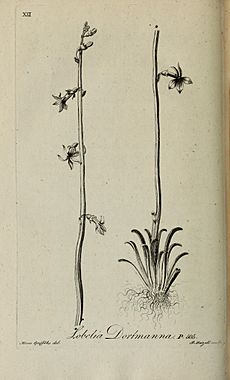John Lightfoot (biologist) facts for kids
Quick facts for kids
John Lightfoot
|
|
|---|---|
| Born | 9 December 1735 Newent, Gloucestershire, England
|
| Died | 20 February 1788 (aged 52) |
| Awards | Fellow of the Royal Society, 1785 |
| Scientific career | |
| Fields | Botany, Conchology |
| Influences | Joseph Banks, Thomas Pennant |
John Lightfoot (born December 9, 1735 – died February 20, 1788) was an English parson-naturalist. This means he was a church minister who also loved studying nature. He spent a lot of his free time as a conchologist, someone who studies seashells, and a botanist, someone who studies plants.
Lightfoot was very good at organizing and looking after the private museum of Margaret Bentinck, Duchess of Portland. He is most famous for his book Flora Scotica. This book was very important because it was the first scientific study of plants and fungi in Scotland. Because of his great scientific work, he was chosen to be a Fellow of the Royal Society.
Contents
Who Was John Lightfoot?
Early Life and Education
John Lightfoot was born in Newent, a town in Gloucestershire, England. His father, Stephen Lightfoot, was a farmer. John went to Pembroke College, Oxford for his education. He earned his first degree in 1756 and a master's degree in 1766. Later, in 1785, he became a Fellow of the Royal Society because of his contributions to science.
Lightfoot's Work as a Curator
Lightfoot worked as a church minister, or Rector, in Gotham. He was also a chaplain and librarian for Margaret Bentinck, Duchess of Portland. He also served as a curate in Colnbrook and then in Uxbridge, Middlesex. He kept the Uxbridge job for the rest of his life.
His church duties were not very demanding, which gave him lots of time. He used this time to manage the Duchess's amazing collection. This collection was like a "Cabinet of Curiosities," full of interesting objects. Lightfoot did an excellent job, creating a detailed list and description of everything. This list was later published as an auction catalog after the Duchess passed away. One very famous item he looked after was the ancient "Portland Vase," a beautiful Roman glass vase.
Friends and Journeys of Discovery
By 1770, Lightfoot became good friends with Joseph Banks, a leading botanist in England. He also befriended Daniel Solander, who was a student of the famous Swedish botanist Carl von Linné. This was a time when scientists loved to travel and discover new things. Banks and Solander even sailed with Captain James Cook on a trip to the Pacific Ocean!
Lightfoot himself traveled from Chester to Scotland. He went with the Welsh writer Thomas Pennant and another minister, Rev. J. Stewart. This journey helped Pennant write a popular book. More importantly, it gave Lightfoot most of the information he needed for his own book, Flora Scotica. He paid to publish this book himself in 1777.
Lightfoot knew many other important scientists of his time. These included people like William Hudson, James Dickson, and James Edward Smith. He lived just long enough to see the Linnaean Society, a famous group for naturalists, founded in 1788.
Other Writings and Discoveries
Besides Flora Scotica, Lightfoot wrote another book in 1786. It was called An Account of Some Minute British Shells. This book described tiny British seashells that other scientists had not noticed or studied well. He also described new animal species, like the reed warbler, a type of bird, in 1785. He traveled in Wales to study plants there, but his notes on Welsh plants were never published.
Family and Later Life
In November 1780, John Lightfoot married the daughter of William Burton Raynes. Mr. Raynes was a rich miller from Uxbridge. John and his wife had five children together: two sons and three daughters.
John Lightfoot passed away in Uxbridge and was buried in Cowley, Middlesex. He had a large collection of books, which were sold after his death. Some of his plant collection can still be found today at the Royal Botanic Gardens, Kew.
Flora Scotica: A Landmark Book
Flora Scotica: or, a systematic arrangement, in the Linnaean method, of the native plants of Scotland and the Hebrides is John Lightfoot's most important work. It was published in London in 1777. It's a very big book, with two volumes and a total of 1151 pages!
Many of the pictures in the book were drawn by Moses Griffith, who was Thomas Pennant's artist. These drawings were then carved onto plates by Peter Mazell to be printed. Some pictures were even drawn and engraved by Mazell himself.
The book covers not only flowering plants but also "Cryptogamia." This group includes ferns, mosses, algae, and fungi. Lightfoot also wrote about liverworts, which are small green plants. He even included "Lichen" as a type of "terrestrial algae," meaning algae that grows on land.
Experts today say that while some of his plant classifications might seem a bit different now, most of the species he wrote about can still be identified today. He was also the first person in Britain to record finding the delicious chanterelle mushroom and the summer truffle.
The book includes an "English and Scotch Index of the Names of Plants." This part is actually all in English. There is also an "Erse Index," which lists Gaelic names for plants. Finally, there's a Latin index for the plant groups, or genera.
Species Named After Him
The plant group Lightfootia, which belongs to the bellflower family (Campanulaceae), was named in John Lightfoot's honor. It was named by a French botanist named Charles Louis L'Héritier de Brutelle.
However, some other species that have "Lightfoot" in their name are not named after John Lightfoot. For example:
- Epinephelus lightfooti was named after Benjamin H. Lightfoot, who collected fish in the Caribbean.
- Terebra lightfooti and Zafrona lightfooti were named after Robert M. Lightfoot from the South African Museum.
Images for kids







